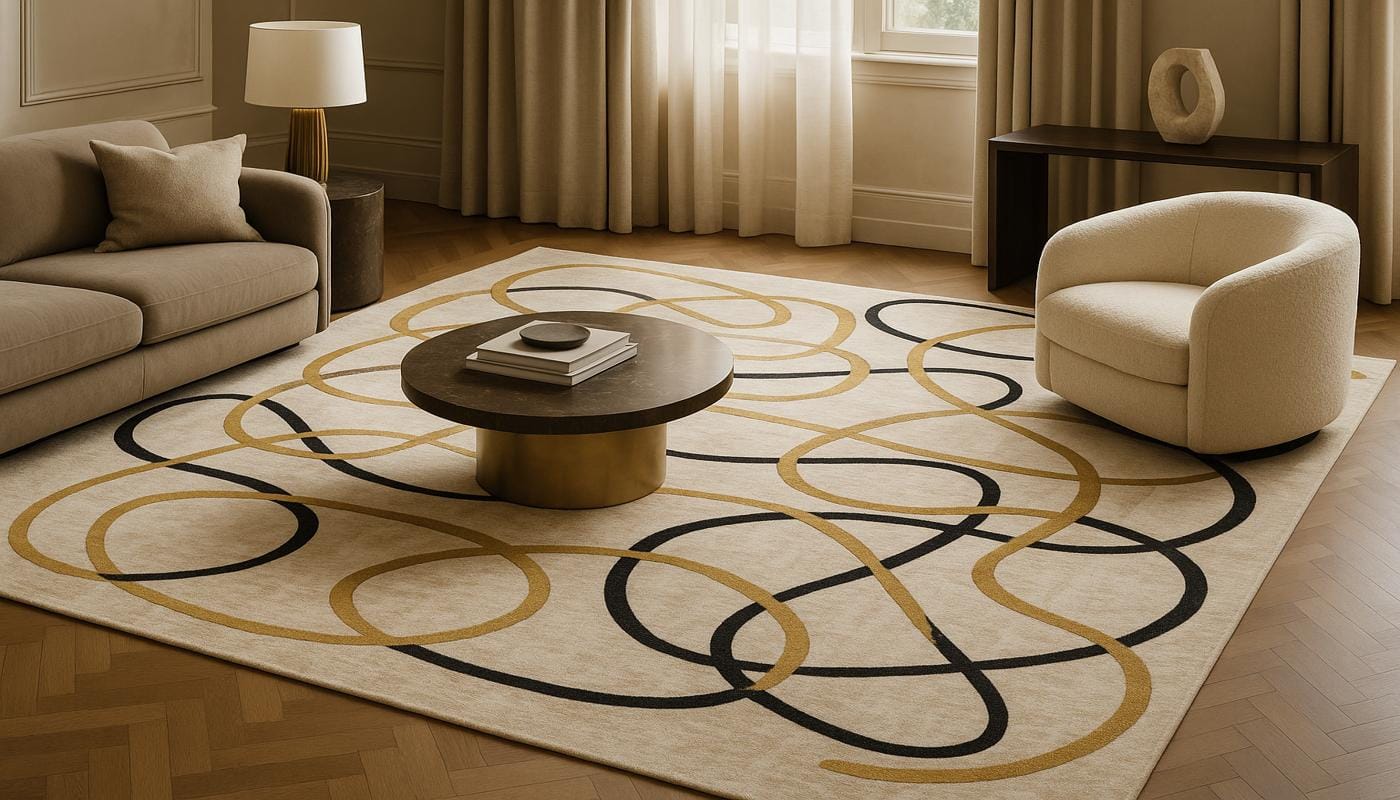Why Rugs Matter
At FCI London, we have decades of experience when it comes to designing truly refined spaces, and we believe that nothing ties a room together – or tears it apart – quite like the perfect rug.
Having specified floor covering for projects that range from country farmhouses to studio apartments to luxury villas, we have noticed a pattern: many homeowners tend to undermine a rug’s value, often treating them as mere afterthoughts to fill up some space rather than actual interior elements that need to be worked in with precision and care.
Today, a diverse range of rugs awaits you in the market, ranging from exquisite hand-knotted Persian masterpieces that can serve as a family heirloom to outdoor rugs that can accommodate the strong Arab sun. We have compiled all our hard learned tips and tricks in this comprehensive guide that will help you select the perfect rug to adorn your floorings.
Start with Function, Not Fashion
We will often see clients gravitating towards a stunning vintage hand-knotted Persian rug, only to discover that it’s to be placed in their kitchen or living room area – a grave mistake.
Yes, looks are important, but before even going into the aesthetic value, consider its functional needs through these questions:
- Where will you be using this rug?
- What level of foot traffic will it have to face?
- Will it be exposed to spills, pets, or children daily?
- What level of maintenance can you undertake?
These questions impact the type of rug that would be recommended to you. For instance, if you’re selecting an outdoor rug to enliven your villa’s terrace, it’s wise to choose materials that can endure intense UV exposures. The type of rug style you choose will be secondary in your list of priorities when faced with survival. The same rules will apply to kitchen rugs and bathroom rugs.
A rug’s material must always be aligned with its intended usage and purpose to ensure that it serves your floors for several years with minimal effort on your part.
Size Matters (More Than You Think)
Often, we visit luxuriously decorated residences only to find stunning yet criminally undersized rugs floating awkwardly in rooms of vast dimensions. It’s like wearing trousers that end mid-calf – they serve their basic function but make for a horrible visual.
As a rule of thumb, when considering rug placement for the living room, your carpet should be large enough to subtly be overlapped by the furniture legs of all your pieces, such as sofas, armchairs, consoles, media units, etc. Always choose big rugs for the living room, going as large as your budget can allow, with a mere 30-45cm of flooring being visible around the perimeter.
When working with the classic round rugs, choose the standard 150cm size to allow perfect placement in transitory areas such as foyers and hallways, where it serves as a visual anchor without overwhelming or crowding the space.
Your rug size should vary according to the spatial requirements of your room and lifestyle, but to be on the safe side, it’s always better to go a bit larger than you need instead of the other way around.
Material Choices: The Unsung Heroes
The material of the rug greatly impacts its visual appeal and the tactile experience it offers for your bare feet, yet it also impacts the longevity and maintenance requirements.
Having spent years providing luxury rugs for our discerning clients across a range of materials, we have concluded that wool reigns as the best choice for indoor rugs. The natural fibre is stain-resistant, durable, cosy, and retains a fresh appearance for countless years.
Jute rugs offer a timeless appeal and are back in trend as they offer a wonderful dose of character and texture to the floor without any overbearing patterns or designs. Yet it’s important to keep in mind that while a jute rug is quite appealing visually, it can be quite a pain to maintain regularly. Reserve your jute and sisal rugs for areas with less traffic. Try placing your jute rug under the dining table or the centre tables. A dark grey jute rug or even a navy blue jute rug can help disguise some wear and tear, but they remain vulnerable to any accidental spills.
For areas demanding extreme durability, such as kitchens, bathrooms, and the outdoors, synthetic blends serve as the material of choice. The synthetic fibres today can mimic the cosy, tactile appeal of indoor rugs while offering a strong endurance against fading, staining, and moisture.
Hand-Knotted Persian Rugs: The Gold Standard
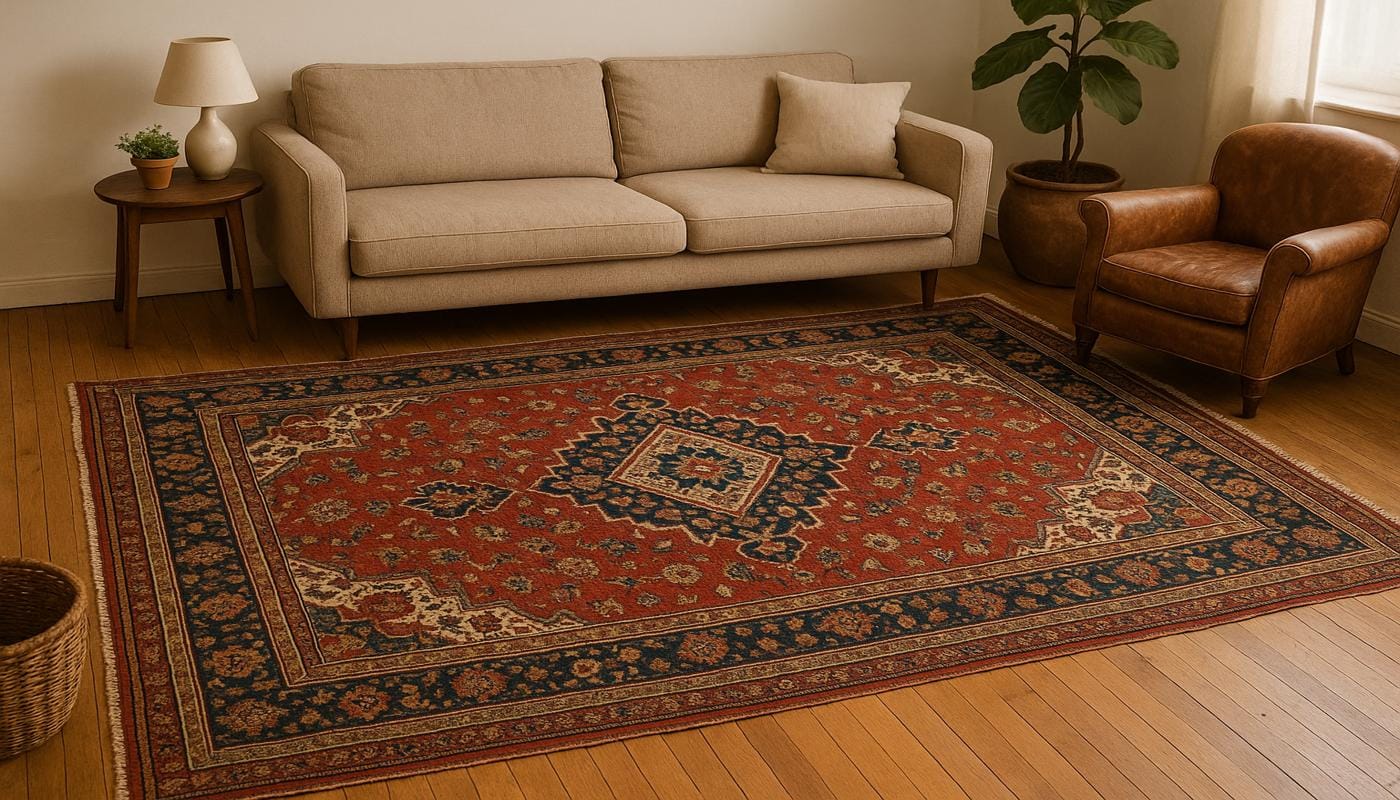
There’s a good reason why antique hand-knotted Persian rugs end up appreciating with time. These pieces are the epitome of fine rug craftsmanship, with artisans often spending years of hard work to create a single masterwork.
Persian rugs are popularly recognised for their deep tones. The blue Persian rug is a client favourite for its cool yet striking presence, whereas a red Persian rug serves as the perfect conversation piece for living rooms. Although traditional Persian rug patterns are iconic on their own, modern Persian rugs play on the traditional patterns with a touch of textural minimalism for a whimsical head-turner.
The beauty of a Persian covering also lies in its versatile nature. While it blends seamlessly in traditional and classic interiors, it also wonderfully juxtaposes with contemporary, minimalist environments. Investment pieces are always known to adapt seamlessly beyond trends.
Colour, Pattern, and Texture: Layering Like a Pro
Your rugs need to be incorporated within a room’s design scheme by keeping them aligned with your colour strategy.
Neutral rugs are the safest way to add texture without clashing with other interior elements, serving as a canvas. On the other hand, round patterned rugs are statement pieces that can unify different design elements in a room. Rugs with a strong colour profile, such as red and blue Persian rugs or green jute rugs, can provide visual cues to mirror that colour in subtle details such as artworks and accessories.
For clients who seek to create textural masterpieces, we recommend layering a small vintage rug over a neutral area rug, which brings a beautiful depth to the floors.
Choosing Rugs for Specific Spaces
Living Rooms
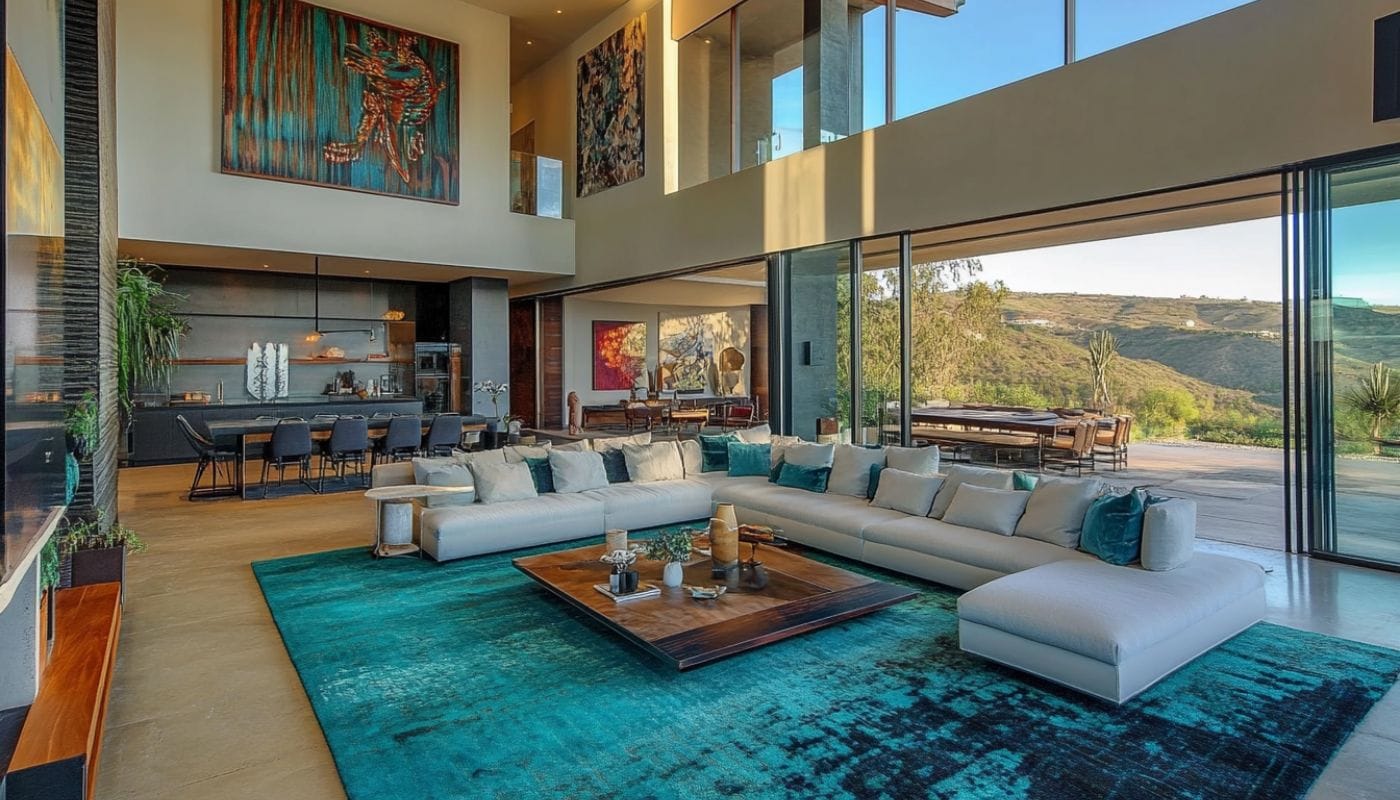
Living room rugs add a cosy warmth and texture, enlivening the space with a subtle approach. Yet perhaps even more important is its role in creating a conversational pit. Big rugs for the living room are ideal for anchoring the furniture pieces and enhancing a sense of cohesion. For spacious, open-plan layout living rooms, rugs provide the perfect way for you to define and delineate different zones: reading corner, seating area, media space, coffee sitting, and hallway.
Fluffy living room rug selections are difficult to maintain due to their high pile, yet they add an unmatched opulence, which makes them best suited to formal spaces. Washable living room rugs are ideal for family areas with high foot traffic.
When deciding the rug placement in your living room, make sure that each rug is per the room’s dimensions and spatial arrangement.
Kitchens

Modern kitchens are all about achieving that delicate balance between form and function. A well-selected kitchen rug should be practical but stylish. Choose hard-wearing synthetic materials that can endure frequent spills and regular cleaning.
Kitchen area rugs must be thoughtfully placed under the tables or serving bars rather than preparation areas so that they’re not creating a tripping hazard near the stovetops. For cooking and prep areas, choose chef kitchen rugs that provide cushioning underfoot with a strong suction to prevent any spillages, while being easy to clean. Similarly, a kitchen sink rug can make dishwashing more comfortable while adding colour and texture to the space.
Bathrooms
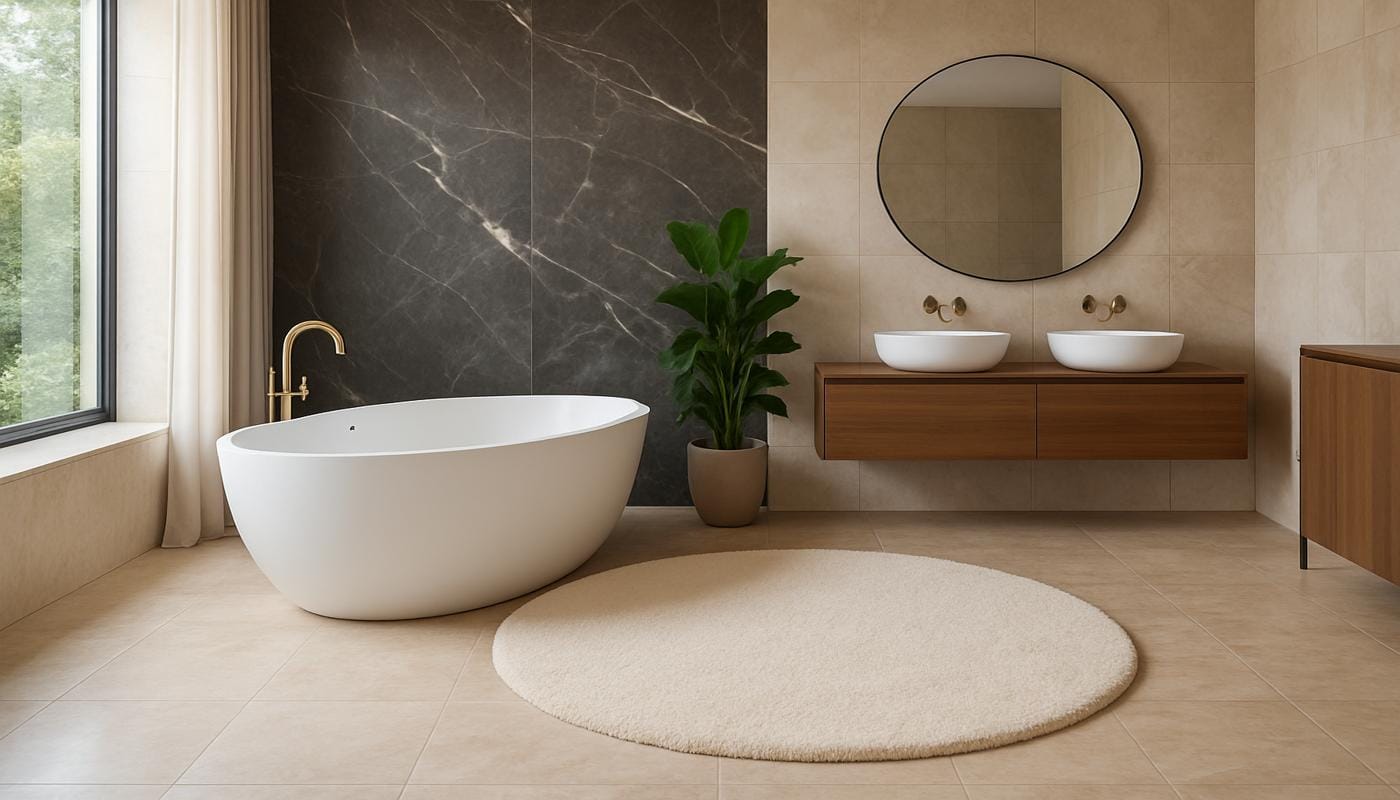
Adding a bathroom rug serves as the perfect chance to add a licable, cosy quality to a space that has the risk of looking too clinical and bland. You can channel the soothing ambience of a luxury spa with a well-placed rug. Synthetic options are better at surviving a bathroom’s humidity levels, whereas a bamboo bath rug can add natural textures in more well-ventilated parts.
Round bath rugs are excellent for emphasizing statement features in your space, like a freestanding tub or jacuzzi, while square bath rugs work better near contemporary vanities.
Children's Spaces
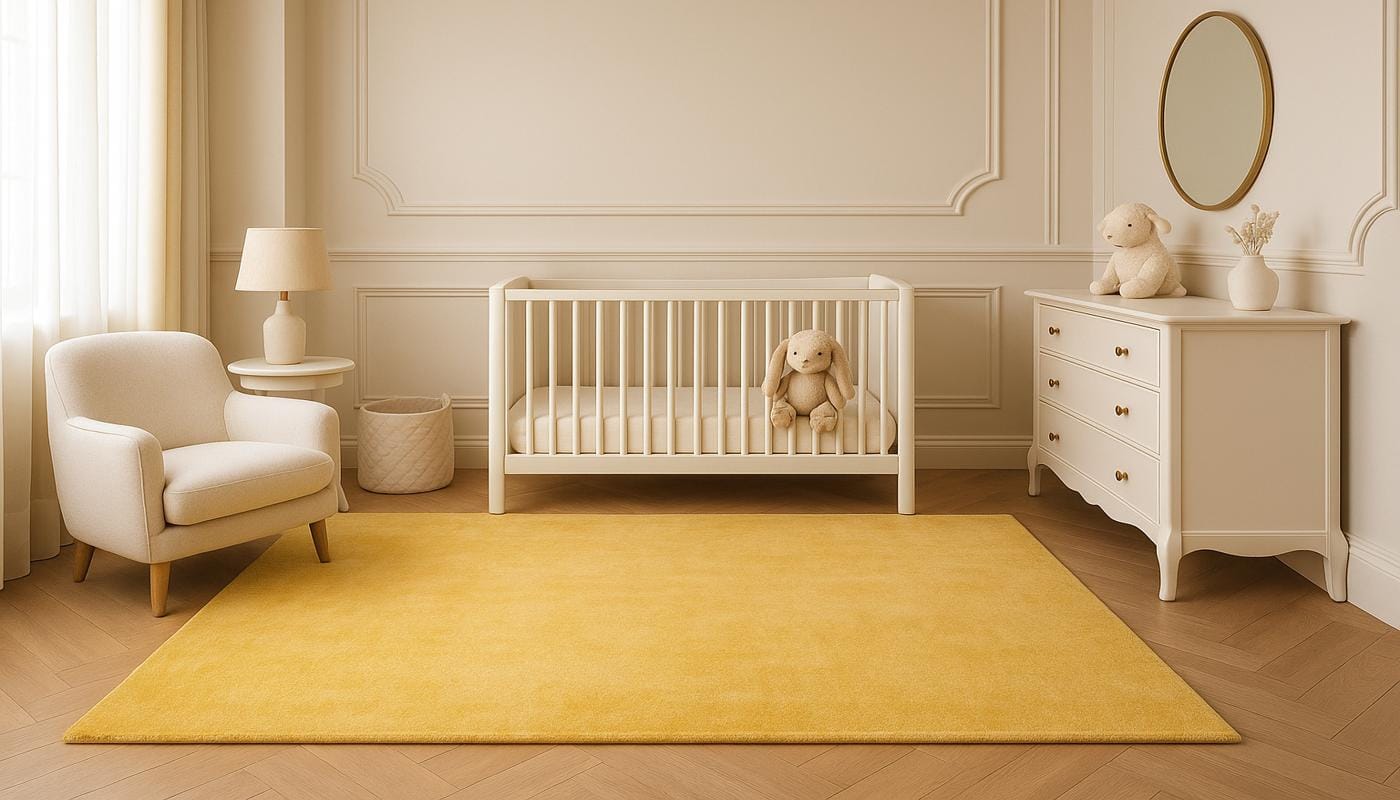
When designing your little one’s room, make sure that the nursery rug extends beyond merely the crib area to create a safe and comfortable crawling space that will later serve as a cosy play area. Kids rugs play an important part in making the place comfortable and safe for them.
The best nursery rugs are made with non-toxic and soft materials. Many parents seek organic rugs for the nursery to ensure that. A round rug for a kids’ room eliminates sharp corners that can become a tripping hazard.
Nursery rugs for boys might feature subtle marine or animal motifs, while baby girl nursery rugs often incorporate softer palettes. Many clients prefer a gender neutral approach as it offers better versatility, for which neutral and earthy tones are optimal.
Outdoor Areas

Outdoor rugs have evolved incredibly over the years. We no longer have to adorn our outdoors with horrible colours and plastic-like textures to stay practical.
Large outdoor rug installations transform barren terraces into proper outdoor rooms. Modern outdoor rugs offer sophisticated designs in refreshing tones. A grey outdoor rug, or an outdoor jute rug, works well with most exterior colour schemes. A Turkish outdoor rug adds pattern to your patios and terraces while maintaining excellent quality.
Carpets and Rugs: When to Choose Which
While they are both floor coverings, understanding the difference between rugs and carpets is fundamental to learning which one your floors are calling for. A carpet will usually extend wall-to-wall and is fixed in place, whereas rugs are loose-laid and usually cover only a portion of the floor.
In formal spaces like drawing rooms and studies, wall-to-wall carpets provide consistent comfort and acoustic dampening. Yet clients who invest in high-quality hardwood floors don’t want to completely cover them up, instead preferring an area rug, or a combination of multiple small rugs to add some warmth.
Climate also plays a part when choosing between rugs and carpets. Carpets can add too much warmth due to their insulating properties and are not recommended for warmer climates like the UAE.
The Transformation of the Workplace Through Fit Outs
There are a few common mistakes made with rug selection that can easily be avoided with some guidance:
- Undersizing: Selecting rugs that are too small can completely ruin the spatial balance of your room. Always measure and mark out your intended rug size with tape before making the purchase.
- Disregarding maintenance realities: We all love a cream coloured, lush fur rug, but with children or pets running around, it’s only a setup for disappointment in the long run. Make the practical calls
- Pattern overload: A checkered rug will clash badly with heavily patterned upholstery. Create a balance between solids, patterns, and texture – always preferring to keep things simple rather than overdone.
Curate, Don’t Just Decorate
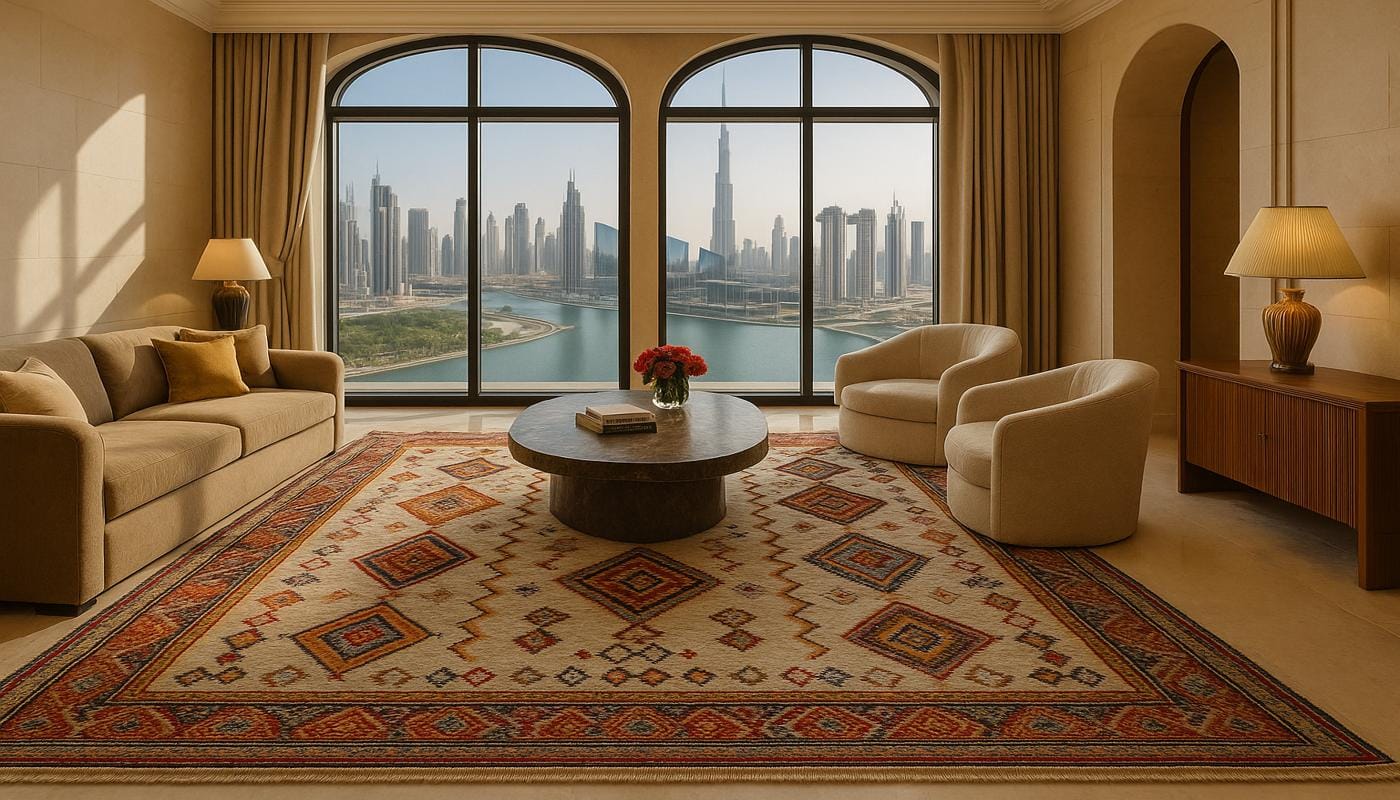
A well-selected luxury rug will serve you for decades as an heirloom investment, not just another impulse-bought interior décor piece. Consider the buying process for rugs as a careful curation instead of mere decoration. The most successful interiors we’ve designed over the years feature rugs that feel like they have always belonged, not just added in to fill the floors.
With a plethora of rugs Dubai options that range between varying sizes, materials, colours, and styles, the journey to selecting one that resonates well with you and your space can be quite a challenge – a challenge that FCI UAE is well-equipped to overcome.
With over 3,000 luxury rugs in our collection, an award-winning team, and decades of experience to back our claims, we can help you make the right rug call. Our bespoke rug design centre allows us to create a custom rug in any design and colour scheme of your choice. Get in touch today for a free consultation with our expert team.
Frequently Asked Questions
High end floor coverings imply luxury not just in unmatched aesthetics, but a superior tactile feel and enhanced longevity. They are usually made using natural luxury fibres such as silk or wool, and involve meticulous, labour-intensive techniques such as hand-knotting.
Thousands, if not millions, of loops of yarns are tied meticulously by hand. The fibres are then sheared off to reveal a thick, condensed and plush pile that offers unmatched durability, comfort and richer colours.
For a bedroom, the ideal layout is to place a large area rug under the bed so that it centres the focal point of your room, while simultaneously providing a warm, comfortable landing for your feet in the morning. For larger bedrooms, you can layer multiple rugs to define zones such as near the dresser, around the seating area, near a reading nook, and more.
Using a strong padded backing with grippers can greatly prevent slippage and improve comfort levels. Modern hacks such as double-sided rug tapes along the edges or the classic anchoring with furniture legs ensures your rugs serve warmth without compromising on safety.
Rugs can be used to add texture, cohesion, warmth, insulation and acoustic control in any interior space. They can also be used to define specific zones within larger or open-layout areas, or help anchor furnishings to prevent a floating effect.


